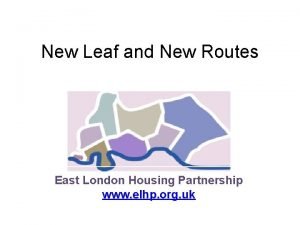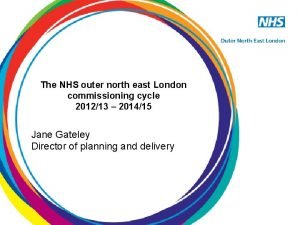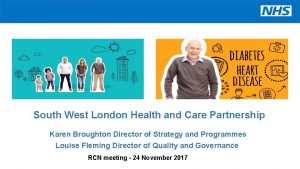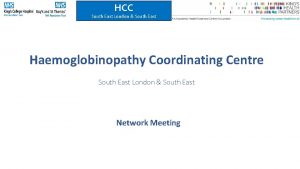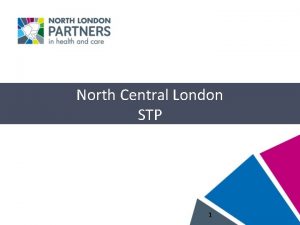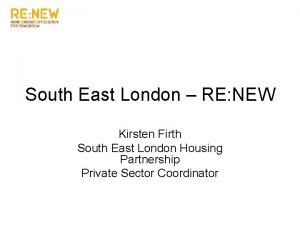Anna Lucas South East London STP Georgie Herskovits















- Slides: 15

Anna Lucas, South East London STP Georgie Herskovits, Healthy London Partnership

We aim to address three problems in local healthcare: • The health and wellbeing gap – people should be helped to lead healthier and longer lives • The care and quality gap – variation in the accessibility and quality of care should be improved • The funding and efficiency gap – the NHS must become more efficient and make better use of the money available

The priorities for the programme were established in 2018/19 and include children and young people’s: • mental health and wellbeing • urgent and emergency care and long-term conditions • Special Educational Needs and Disability and Autism If successful we will see: • better physical and emotional support for families • more joined-up health and care services • easy access to the right services first time • shorter inpatient stays in hospital • fewer emergency admissions • straightforward transition into adult services

CYP commitments Overarching changes: • Roll out of Integrated Care • CYP Transformation Programme Systems • 0 -25 services • Decision making and • Mental health accountability • Learning disability and autism • Primary Care Networks • Cancer • Changes to how care is delivered • Workforce • Public health • Legislative change • Health inequalities • Maternity services • Support for carers and vulnerable families

• SEL stakeholder workshops held in March and April 2019 • Defined the problem o Children using Urgent & Emergency Care when they don’t need to or because their long-term condition has not been well-managed. • Develop a Case for Change o Family; Professionals; Primary care and Schools Perspectives • Create Vision • Strengthening community support • Hospital@Home • Developing integrated clinical networks and clinics (shared learning and paediatric clinics running in the community) • Next steps

Healthy London Partnership (HLP) We aim to make London the healthiest global city in the world by working with our partners for Londoners to improve health and care, so everyone can live healthier lives. Purpose • Bring together partners with improvement and transformation experts and Londoners, to work towards the common goals set out in Better Health for London, NHS Five Year Forward View, the Devolution agreement and now the NHS 10 Year Plan. • Develop an evidence base so we inspire London to be the best it can be, gathering insight and data, building on local successes and sharing learning and best practice. • Tackle issues best solved ‘once for London’ by pooling resources and attracting additional funding to specific London issues like homelessness or access to GPs. Provide strategic challenge and robust governance through the London Health Board and the London Strategic Partnership Board. www. healthylondon. org/ @Healthy. LDN 6

London asthma data • One of top three causes of hospital admission for CYP • CYP with asthma action plan four times less likely to be admitted to hospital (Asthma UK) • Estimated that 75% admissions and 90% deaths preventable with optimal care • Annual cost unplanned admissions and PICU admissions £ 5. 6 million across London • Investment in asthma reduces inpatient costs and improves self management, quality of life, reduces time off from school 7

SEL asthma data 8

London Programme: Transforming the whole system through improved co-ordinated care, ambitions and standards for asthma care in CYP Support across the system to improve asthma care, reduce mortality, morbidity and admissions https: //www. healthylondon. org/children-and-young-people/london-asthma-toolkit Ambitions ‘The London asthma standards for children and young people have been reviewed and published as a NICE Shared Learning example’ 9

Why do we need to do this? 3000 LAS calls a year 3 pupils in every classroom have asthma The Ella Roberta story https: //app. box. com/s/h 0 sfrrmdczgcu 9 tk 3 fuweryugb 2 ghi 7 a 10

We need to learn from these cases Missed opportunities • No co-ordinating record, or analysis of frequency • No appreciation of underlying severity or risk factors or deteriorating nature of their conditions • No single clinician with overall responsibility • No coherent management plan or PAAP • Not referred to specialist respiratory paediatrician • Assessment and management of condition not in accordance with BTS/SIGN guidelines or NICE Quality Standards • No effective communication between primary and secondary care • Excess salbutamol (reliever) prescriptions and the presence of a home nebuliser, failure to collect preventer inhalers • Failure to recognise on-going and future risks

What are networks? “Linked groups of professionals and organisations from primary, secondary and tertiary care, working in a co-ordinated manner, unconstrained by existing and professional (and organisational) boundaries, to ensure equitable provision of high quality, clinically effective services” The Scottish Office Department of Health, 1999 The Introduction Of Managed Clinical Networks in Scotland

Why have networks? • Promote uptake of evidence based practice (use of data) • Drive improvements in standards of patient care • Engage clinicians in improved models of care • Integration of services and multidisciplinary • Allow for continuous working relationships across boundaries • Improved flow of knowledge and best practice between individuals and organisation • Improved quality and access of care for patients

#Ask. About. Asthma campaign Organisations are asked in Sept (week 38) to pledge to: • Implement the asthma standards • Implement asthma ambitions for London • to pledge to reduce their impact on air pollution as a major trigger of asthma Three key messages: • Asthma management plan • Effective inhaler use • Annual review 14

Support to NHS trusts reduce their air pollution Three types of interventions described: Ideas that are free to implement • Encouraging staff and patients to walk/take public transport • Encouraging use of car pools • Using volunteers to reduce engine idling outside premises • Demonstrating support for Mayor's air quality strategy Ideas which can save an organisation money • Reviewing products purchased • • • Encouraging bulk deliveries Reducing waste Supporting the “circular economy” Ideas which may cost money (potentially funded through trust charity funds) • Planting nitrogen fixing plants/green wall • Use air quality sensors • Clean air benches • Pollution-reducing paint Download the Toolkit for NHS Trusts. 15
 South east london stp
South east london stp Orthopaedic surgery south east london
Orthopaedic surgery south east london Horizontal movement of air
Horizontal movement of air East london housing partnership
East london housing partnership Outer north east london
Outer north east london East london port
East london port South west london health and care partnership
South west london health and care partnership Rape crisis south london
Rape crisis south london Ymca london south west
Ymca london south west Near east vs middle east
Near east vs middle east East is east and west is west
East is east and west is west North east west south map
North east west south map Lesson 8 middle east and south asia
Lesson 8 middle east and south asia Southeast asian ministers of education
Southeast asian ministers of education South east midlands lep
South east midlands lep North east south west
North east south west



